Tamil-Brahmi
Tamil-Brahmi also known as Tamili or Damili[3] is a variant of the Brahmi script used to write inscriptions in the early form of the Old Tamil language.[4] The Tamil-Brahmi script has been paleographically and stratigraphically dated between 3rd century BCE and 1st century CE, and it constitutes the earliest known writing system evidenced in many parts of Tamil Nadu, Kerala, Andhra Pradesh and Sri Lanka. Tamil Brahmi inscriptions have been found on cave entrances, stone beds, potsherds, jar burials, coins,[5] seals, and rings.[4][6][7]
| Tamil-Brahmi | |
|---|---|
.jpg.webp) | |
| Type | |
| Languages | Old Tamil |
Parent systems | Proto-Sinaitic alphabet?[a]
|
Child systems | Vatteluttu, Pallava[2] |
Sister systems | Bhattiprolu script |
[a] The Semitic origin of the Brahmic scripts is not universally agreed upon. | |
| Brahmic scripts |
|---|
| The Brahmic script and its descendants |
Tamil Brahmi resembles but differs in several minor ways from the Brahmi script inscriptions found elsewhere on the Indian subcontinent such as the Ashokan edicts found in Andhra Pradesh.[8] It adds diacritics to several letters for sounds not found in Prakrit, producing ṉ ṟ ṛ ḷ. Secondly, in many of the inscriptions the inherent vowel has been discarded: A consonant written without diacritics represents the consonant alone, whereas the Ashokan diacritic for long ā is used for both ā and short a in Tamil Brahmi. This is unique to Tamil Brahmi and Bhattiprolu among the early Indian scripts. Tamil Brahmi does not, however, share the odd forms of letters such as gh in Bhattiprolu. This appears to be an adaptation to Dravidian phonotactics, where words commonly end in consonants, as opposed to Prakrit, where this never occurs. According to Mahadevan, in the earliest stages of the script the inherent vowel was either abandoned, as above, or the bare consonant was ambiguous as to whether it implied a short a or not. Later stages of Tamil Brahmi returned to the inherent vowel that was the norm in ancient India.[8]
According to Kamil Zvelebil, Tamil-Brahmi script was the parent script that ultimately evolved into the later Vatteluttu and Tamil scripts.[2]
Origins
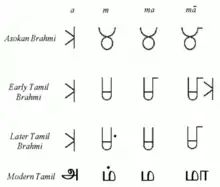
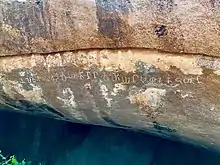
Early Tamil scripts
An early mention of a script for writing the Tamil language is found in the Jaina work Samavayanga Sutta and Pannavana Sutta where a script called Damili is mentioned as the seventeenth of eighteen Lipi (scripts) in use in India.[10] Similarly, the tenth chapter of the Lalitavistara, named Lipisala samdarshana parivarta, lists Dravida-lipi and Dakshinya-lipi as two of sixty four scripts that Siddhartha (later the Gautam Buddha) learnt as a child from his gurus in Vedic schools, a list that is found in both Indian Buddhist texts and its ancient Chinese translations.[11][12] These relationship of early Tamil scripts to these lipi mentioned in Jaina and Buddhist literature relationship is unclear. The pre-1974 work of Mahadevan had established 76 rock inscriptions in Tamil Brahmi from about 21 sites in Tamil Nadu, which states Kamil Zvelebil "establish obvious correlations" with what has been found in early Tamil bardic poems.[13] Nagaswamy treats Tamil-Brahmi script to be synonymous with the Damili script in his publications.[2]
Artifacts such as inscribed potsherds, coins or others are found in Tamil Nadu archaeological sites have graffiti and inscriptions.[14] The potsherds recovered from Kodumanal, for example, have markings that on the basis of stratigraphical analysis appear to be from the 4th century BCE.[14] According to K. Rajan, the "large number of graffiti marks and subsequent Tamil Brahmi script" unearthed in Tamil Nadu and Kerala suggest that this region had a "linguistic cohesiveness well before 5th-4th century BCE".[14]

Pre 1990s
The origins and chronology of Tamil Brahmi are unclear. Several hypotheses have been proposed, with the views of epigraphist Iravatham Mahadevan being generally more accepted.[15] According to Mahadevan, the Brahmi script from North India arrived via the southern inscriptions of Ashoka, and evolved into the Tamil Brahmi.[16] This theory presupposes that the Brahmi script itself was either originated within the imperial courts of Mauryan kingdom or evolved from a more ancient foreign script and it was dispersed to South India and Sri Lanka after the 3rd century BCE. The alternate theory proposed by Nagaswamy is that there was an indigenous common source (proto-Vatteluttu) script from which both northern and southern Brahmi script emerged, which he respectively terms as Brahmi and Damili scripts.[16] Richard Salomon favors the Mahadevan theory.[15]
According to Kamil Zvelebil's chronology proposal of 1973, the earliest Tamil Brahmi inscriptions such as the Netunceliyan rock inscriptions at the Mangulam site were derived from Ashokan Brahmi that was introduced to the Tamil region around 250 BCE.[17] It was adapted for the Tamil language by 220 BCE and led to the standardization of the Tamil language and literary norms of Maturai between 200 and 50 BCE.[17] These developments transformed the oral bardic Tamil literary culture to the written Sangam literature in the centuries that followed. The use of Tamil Brahmi continued through the 6th century CE, states Zvelebil.[17]
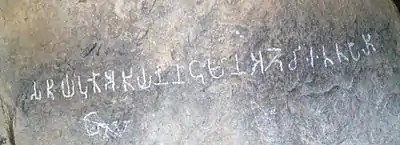
Since 1990s
Since the 1990s, pre-Ashokan dates have been proposed based on excavations and discoveries of graphite covered ancient remains in Sri Lanka.[18] These include those found in Anuradhapura in Sri Lanka, some of which have been dated to the 4th century BCE.[19][20] The findings of Coningham et al based on the carbon dating of excavated potsherds led to the proposal that the Sri Lankan Brahmi developed before Ashokan era, at least by the 5th to 4th century BCE, from where it came to Tamil region evolving into the Tamil Brahmi, and thereafter spread across South Asia due to trade networks.[21] Sri Lankan nationalists have used this and other fragments of Black-and-Red Ware and Red Ware with Brahmi characters to state that Brahmi was invented on the island and from there it migrated north into the Indian subcontinent.[21] This theory has been criticized by Harry Falk – a scholar of Brahmi and other ancient Indian scripts. First, states Falk, the Coningham team has admitted later that they did not use the carbon dating correction necessary for the Southern hemisphere and used the calibration curves for north Pakistan.[21] Second, the Sri Lankan teams also erred when they deployed a "mathematical trick" whereby they conflated the contested date of lower strata that lacked inscribed shreds with the upper strata where the shreds with Brahmi script were found.[21] According to Falk, a critical study of the feature differences between Ceylonese (Sri Lankan) Brahmi, Tamil Brahmi and Ashokan Brahmi suggest that "all the differences can only be explained once the Ashokan script is taken as primary and the two others as derivations". It is not scholarship that is behind the claims that Ceylonese Brahmi is more ancient and gave rise to Tamil Brahmi and Ashokan Brahmi, rather it is "regional chauvinism", states Falk.[21]
The graffiti and Brahmi found at sites in Sri Lanka are related, but not considered to be examples of Tamil-Brahmi.[19][22] Archaeological teams sponsored by the government of Tamil Nadu have also been actively unearthing sites and reporting their results in local media that they have found shreds and items with Tamil Brahmi inscriptions.[23] Between 2011 and 2013 for example, Rajan and Yatheeskumar published their findings from excavations at Porunthal and Kodumanal in Tamil Nadu, where numerous graffiti and inscription fragments on archaeological pieces have been unearthed. The radiocarbon dates of paddy grains and charcoal samples found along with potsherds with inscriptions provided a radiometric date of about 520–490 BCE, which state Rajan and Yatheeskumar implies that the inscriptions too are from the same period.[24] Based on Carbon-14 dating by an American laboratory, Rajan suggests Tamil Brahmi had been invented by 490 BCE, and states, "it is almost clear now that Ashoka did not developed (sic) the Brahmi script. The origin or evolution of a script is a social process and it could not be associated with a particular individual or dynasty."[25] Responding to Rajan's findings, Harry Falk, wrote that the earliest supposed inscriptions are not Brahmi letters at all, but misinterpreted Megalithic graffiti symbols, which were used in South India for several centuries during the pre-literate era. The stirrups reportedly found with the shreds are suspicious. Falk considers these reports as "regional chauvinism" just like the Sri Lankan claims of their island being the origin of Brahmi script development.[25] According to linguist David Shulman if these early dates are correct then the transition to proto History needs to be pushed backed to fourth or even fifth century BCE, but he concurs there are reasons to be bit skeptical of pre-Ashokan dates for Tamil-Brahmi, but recommends that one should keep an open mind.[26]
The script
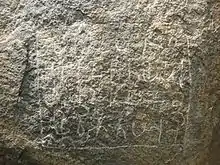
Tamil-Brahmi had notable peculiarities when compared to the Standard Brahmi.[27] It had four different characters to represent Dravidian language phonemes not represented in the standard northern-based Brahmi used to write Prakrit languages. The closest resemblance to Tamil-Brahmi is to its neighboring Sinhala-Brahmi. Both seem to use similar letters to indicate phonemes that are unique to Dravidian languages although Sinhala-Brahmi was used to write an Indo-Aryan Prakrit used in the island of Sri Lanka possibly from ongoing maritime relationship with Gujarat and other parts of India.[28]
The Tamil Brahmi script found in ancient Tamil inscriptions is not consistent. It appears to have existed in three different versions between the 2nd century BCE and 3rd century CE.[29] The third version, assumed to be the basis for early Tolkāppiyam, evolved into the modern Tamil script.[29]
The Bhattiprolu script is related to the Tamil-Brahmi, and is found in nine early inscriptions on stupa relic caskets discovered at Bhattiprolu (Andhra Pradesh).[27] According to Richard Salomon, the Bhattiprolu script reflects innovations in a Dravidian language context, rather than Indo-Aryan languages. Both the Bhattiprolu and Tamil Brahmi share common modifications to represent Dravidian languages. The Bhattiprolu was likely a provincial offshoot of early southern Brahmi script, states Salomon.[30]
According to Iravatham Mahathevan there are three stages in the development of the script. The early stage is dated from the 3rd or 2nd century BCE to 1st century BCE. The later stage is dated from the 1st to 2nd century CE. The third stage is dated from the 2nd century CE to the 3rd or 4th century CE.[31] According to Gift Siromony, the types of Tamil Brahmi writings do not follow a very clear chronology and can lead to confusion in dating.[32] According to K. Rajan, the Ashokan Brahmi corresponds with the Stage II of Tamil Brahmi per Mahadevan’s classification. Hence according to him, Stage I may have to be reassessed from the proposed time line.[14] From the 5th century CE onwards Tamil is written in Vatteluttu in the Chera and Pandya country and Grantha or Tamil script in the Chola and Pallava country. Tamil Brahmi inscriptions in cave beds and coins have provided historians with identifying some kings and chiefs mentioned in the Sangam Tamil corpus as well as related Ashokan pillar inscriptions.[33]
Usage
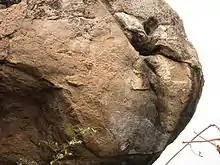
The Tamil Brahmi script inscriptions are predominantly found with ancient Tamil Jaina and Buddhist sites, states Zvelebil.[16] According to Ranjan, all the Tamil-Brahmi inscriptions found in rock caves of Tamil Nadu are related to Jainism.[34] The Tamil-Brahmi inscriptions are also found in secular context such as coins, potsherds and others.[35] According to Zvelebil, its origins likely were with the Jains and the Buddhists, but it was soon understood and used by kings, chiefs, potters and other common people from a variety of backgrounds. This is evidenced by the use of a fused Tamil and Prakrit languages in the secular inscriptions.[36]
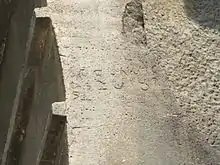
According to Rajan, certain graffiti marks may imply that the script was used for funerary and other purposes.[14] The language used in most of the religious inscriptions show Prakrit elements and influence.[37][38] Cave and rock bed Tamil Brahmi inscriptions, as well as those found near Madurai, are typically donatory and dedicated resting places and resources for monks. Other major usages of Tamil Brahmi inscriptions are similar to those found in Andhra Pradesh, such as in coins and those that mention merchants and traders of gold, sugar, iron, salt and textiles.[39] Some Tamil Brahmi inscriptions mention the names of ancient kings, heroes, and places. This has served as an important and a more reliable means to date Tamil literature and history from about the 3rd century BCE and thereafter.[40]
A significant archaeological source of Tamil Brahmi inscriptions has been the region between Palghat gap and Coimbatore along the Kaveri river and to its delta.[41] The excavations here revealed nearly two hundred inscribed potsherds along with items relating to iron-smelting and jewelry manufacturing. These inscribed potsherds contain a mix of ancient Indian languages – mostly in early Tamil in Tamil Brahmi, and some in Prakrit languages in Brahmi.[41] These are dated to about 300 to 200 BCE by archaeo-magnetic analysis.[41] They suggest an economic vibrancy, trade and cultural exchange between ancient Tamil region and other parts of India. A similar mix of Tamil Brahmi and Brahmi script is found in shards, potsherds and rock inscriptions all along the coast of the Bay of Bengal, from Salihundam in northeast Andhra Pradesh to ancient near-coast settlements of Tamil Nadu such as those near Vaddamanu, Amaravati, Arikamedu, Kanchipuram, Vallam, Alagankulam and Korkai.[42]
Discoveries at Kodumanal near Coimbatore have unearthed potsherds with Tamil Brahmi inscriptions dated 300 to 200 BCE. These include names mostly in Tamil language (Kannan Atan, Pannan), as well as some in Sanskrit (Varuni, Visaki).[43] According to Mahadevan, this admixture of a few loan words of north Indian languages written in northern Brahmi with those in Tamil Brahmi is neither abnormal nor exception in the epigraphical evidence discovered in Tamil Nadu. This trend continued in centuries that followed where Tamils inscribed Sanskrit words in the Grantha script.[44] According to Vimala Begley, the recent sherds graffiti discoveries in archaeological sites along the coast of Tamil Nadu such as Arikamedu are a mix of Tamil Brahmi, northern Brahmi and Ceylon-Brahmi scripts, and they inscribe both Tamil and Prakrit languages of India. This likely suggests that ancient Tamil Nadu served as one of the important trade staging regions for the Indian subcontinent and beyond.[45]
Decipherment
A. C. Burnell (1874), attempted the earliest work on South Indian paleography, but it was due to the efforts of K. V. Subrahmanya Aiyar (1924), H. Krishna Sastri and K. K. Pillay that it was understood to be written in an early form of Tamil, not Prakrit.[33] The early attempts assumed more Prakrit loan words than what was actually used, hence the decipherment was not entirely successful. Iravatham Mahadevan identified the writings as mostly consisting of Tamil words in the late 1960s and published them in seminars and proceedings.[33] This was further expanded by T. V. Mahalingam (1967), R. Nagaswamy (1972), R. Panneerselvam (1972) and M. S. Venkataswamy (1981).[31]
Significant Tamil Brahmi findings
South Asia
- Potsherds with Tamil Brahmi inscriptions found in Poonagari, Jaffna, 2nd century BCE.[46]
- Black and red ware potsherd in Ucchapanai, Kandarodai, Jaffna.[47]
- a pot rim at Pattanam, central Kerala.[48][49]
- Edakal cave, Ambukuthi hill, Kerala.[50]
- Kodumanal, Chennimalai near Erode[51]
- Porunthal site is located 12 km South West of Palani[52]
- Tirupparankundram hill, Madurai [53]
- Fifth ‘hero’ stone found with Tamil Brahmi inscriptions at Porpanakkottai[54]
- Thenur, Madurai. Script is written on a gold bar.[55]
- a laterite in Karadukka in Kasaragod district, Kerala.[56]
Middle East
- Potsherd with Tamil-Brahmi script found in Oman.[57]
- Fragments with inscriptions in Tamil Brahmi script have been found – along with other records in Indic languages and scripts – in Quseir-al-Qadim, (Leukos Limen) Egypt, all dated to about the 1st or 2nd century CE.[58] These evidence a trade relationship between Indian traders and Egyptian counterparts.[59] Two earlier Tamil Brahmi inscription discoveries at the same site, 1st century CE. The inscribed text is 𑀧𑀸𑀦𑁃 𑀑𑀶𑀺 paanai oRi "pot suspended in a rope net".[60]
- An inscribed amphora fragment in Tamil Brahmi at Berenice Troglodytica, Red Sea (Egypt), dated between 1st century BCE and 1st century CE.[60]
Southeast and East Asia
- Tamil-Brahmi inscriptions in the Tamil language, along with Sanskrit in northern Brahmi script, have been found in archaeological sites of southeast Asian countries such as Thailand, Vietnam, Cambodia and Indonesia. For example, a Goldsmith's touchstone found in Wat Klong Thom (Krabi, Thailand) is among the earliest known Tamil inscription in Tamil Brahmi. It is from the 3rd century CE. This evidence along with other inscriptions found in this region suggests that Tamil goldsmiths were likely settled and working in this region of the southeast Asia in the early centuries of the common era.[61][62]
- Pottery and other items with Tamil Brahmi inscriptions have been discovered in Phu Khao Thong, Thailand and Khuan Luk Pat. They are dated to about the 2nd century CE. They are damaged and incomplete but likely refer to some monk (Tamil: turavon). These suggest a trading, religious and cultural exchange between the Tamil region and southeast Asia.[63] The Tamil Brahmi inscriptions and items unearthed since the 1980s in this region suggest that the cultural and economic exchange included mixed themes with shades of Buddhism and Hinduism.[64]
- The Tamil Brahmi and the northern (Ashokan) Brahmi inscriptions found in Siamo-Malay peninsula and Vietnam are the earliest known evidence of writing in southeast Asia.[65][66]
See also
Notes
- Rajan, K (2008), "Situating the Beginning of Early Historic Times in Tamil Nadu: Some Issues and Reflections", Social Scientist, 36 (1/2): 51
- Kamil Zvelebil (1992). Companion Studies to the History of Tamil Literature. BRILL. pp. 123–124. ISBN 90-04-09365-6.
- Jain, Sagarmal (1998). "Jain Literature [From earliest time to c. 10th A.D.]". Aspects of Jainology: Volume VI.
- Richard Salomon (1998) Indian Epigraphy: A Guide to the Study of Inscriptions in Sanskrit, Prakrit, and the other Indo-Aryan Languages, Oxford University Press, pages 35-36 with footnote 103
- Rajan, K (2008), "Situating the Beginning of Early Historic Times in Tamil Nadu: Some Issues and Reflections", Social Scientist, 36 (1/2): 52
- Iravatham Mahadevan (2003). Early Tamil Epigraphy. Harvard University Department of Sanskrit and Indian Studies. pp. 91–94. ISBN 978-0-674-01227-1.;
Iravatham Mahadevan (1970). Tamil-Brahmi Inscriptions. State Department of Archaeology, Government of Tamil Nadu. pp. 1–12. - Zvelebil 1974, pp. 9 with footnote 12, 11–12.
- Richard Salomon (1998) Indian Epigraphy: A Guide to the Study of Inscriptions in Sanskrit, Prakrit, and the other Indo-Aryan Languages, Oxford University Press, pages 31-36
- Bertold Spuler (1975). Handbook of Oriental Studies. BRILL Academic. p. 44. ISBN 90-04-04190-7.
- Salomon 1998, p. 9 footnote 9.
- Salomon 1998, pp. 8–10 with footnotes.
- Georg Bühler (1898). On the Origin of the Indian Brahma Alphabet. K.J. Trübner. pp. 6, 14–15, 23, 29., Quote: "(...) a passage of the Lalitavistara which describes the first visit of prince Siddhartha, the future Buddha, to the writing school..." (page 6); "In the account of prince Siddhartha's first visit to the writing school, extracted by Professor Terrien de la Couperie from the Chinese translation of the Lalitavistara of 308 AD, there occurs besides the mention of the sixty-four alphabets, known also from the printed Sanskrit text, the utterance of the master Visvamitra,...."
- Zvelebil 1974, p. 9 with footnote 12.
- Rajan, K (2008), "Situating the Beginning of Early Historic Times in Tamil Nadu: Some Issues and Reflections", Social Scientist, 36 (1/2): 40–42
- Salomon 1998, p. 37
- Zvelebil 2002, pp. 94-95
- Kamil Zvelebil (1973). The Smile of Murugan: On Tamil Literature of South India. BRILL Academic. pp. 42–43. ISBN 90-04-03591-5.
- Salomon 1998, pp. 12-14.
- Coningham, Robin; Prishanta Gunawardhana; Gamini Adikari; Ian Simpson. "Anuradhapura (Sri Lanka) Project, Phase I: ASW2". Arts and Humanities Research Council. Archived from the original on 7 March 2013. Retrieved 7 October 2011.
- Coningham, R.A.E; Allchin, F.R.; Batt, C.M. (1996), "Passage to India? Anuradhapura and the early use of Brahmi Script", Cambridge Archaeological Journal, 6: 73–97, doi:10.1017/s0959774300001608
- "Owners' graffiti on pottery from Tissamaharama". Zeitschrift für Archäologie Außereuropäischer Kulturen. Reichert Verlag. 6: 45–47, context: 45–94. 2014.
- Tripathi, Sila (2011), "Ancient maritime trade on the eastern Indian littoral", Current Science, 100 (7): 1084
- Palani excavation triggers fresh debate, T.S. Subramanian, The Hindu (29 August 2011)
- Rajan, K.; Yatheeskumar, V.P. (2013). "New evidences on scientific dates for Brāhmī Script as revealed from Porunthal and Kodumanal Excavations" (PDF). Pragdhara. 21–22: 280–295. Archived from the original (PDF) on 13 October 2015. Retrieved 12 January 2016.
- "Owners' graffiti on pottery from Tissamaharama". Zeitschrift für Archäologie Außereuropäischer Kulturen. Reichert Verlag. 6: 46 footnote 2, context: 45–94. 2014.
- Shulman, D. Tamil: A biography, pp. 20-22
- Salomon 1998, p. 35
- Rajan, K (2008), "Situating the Beginning of Early Historic Times in Tamil Nadu: Some Issues and Reflections", Social Scientist, 36 (1/2): 40–43, 49–52
- Sanford B. Steever (2015). The Dravidian Languages. Routledge. p. 78. ISBN 978-1-136-91164-4.
- Salomon 1998, p. 36
- Mahadevan, Iravatham (1994). "Recent discoveries of Jaina cave inscriptions in Tamilnadu". Rishabh Dev Foundation. Retrieved 14 October 2011.
- Siromony, Gift (January 1982). "The origin of the Tamil script". Tamil Studies. International Institute of Tamil Historical Studies. 8 (23).
- Zvelebil 1974, p. 44
- Rajan, K (2008), "Situating the Beginning of Early Historic Times in Tamil Nadu: Some Issues and Reflections", Social Scientist, 36 (1/2): 49
- Rajan, K (2008), "Situating the Beginning of Early Historic Times in Tamil Nadu: Some Issues and Reflections", Social Scientist, 36 (1/2): 49–52
- Zvelebil 2002, pp. 94–95
- Zvelebil 1974, p. 47
- Zvelebil 2002, p. 95
- Julian Reade (2013). Indian Ocean In Antiquity. Routledge. pp. 355–359. ISBN 978-1-136-15531-4.
- Zvelebil 2002, pp. 124-126 with footnotes.
- Olivelle 2006, pp. 118-119.
- Olivelle 2006, pp. 118-121 with footnote 15.
- Olivelle 2006, pp. 123.
- Mahadevan, Iravatham (1995). "From Orality to Literacy: The Case of the Tamil Society". Studies in History. SAGE Publications. 11 (2): 173–188. doi:10.1177/025764309501100201. S2CID 162289944.
- Vimala Begley (1993). "New investigations at the port of Arikamedu". Journal of Roman Archaeology. Cambridge University Press. 6: 93–108. doi:10.1017/S104775940001148X.
- Mahadevan 2003, p. 48
- Thiagarajah, Siva (2010). "The people and cultures of prehistoric Sri Lanka – Part Three". The Sri Lanka Guardian. Retrieved 14 October 2011.
- Subramanian, T. S. (14 March 2011). "Tamil-Brahmi script found at Pattanam in Kerala". The Hindu. Chennai, India.
- "More studies needed at Pattanam". The Hindu. Chennai, India. 24 May 2013.
- Edakal cave yields one more Tamil-Brahmi inscription. The Hindu (2012-02-09). Retrieved on 2013-07-28.
- Subramanian, T.S. (20 May 2013). "Tamil Brahmi script dating to 500 BC found near Erode at Kodumanal near Chennimalai". The newindianexpress. Chennai, India.
- Kishore, Kavita (15 October 2011). "Porunthal excavations prove existence of Indian scripts in 5th century BC: expert". THE HINDU. Chennai, India.
- Subramanian, T. S. (14 February 2013). "Tamil-Brahmi script discovered on Tirupparankundram hill". THEHINDU. Chennai, India.
- "Fifth 'hero' stone with Tamil Brahmi inscriptions found". Newindianexpress.
- Thenur gold treasure found four years ago is 2300 years' old, recent study reveals
- Newly Discovered Brahmi Inscription Deciphered, The Hindu
- Subramanian, T. S. (28 October 2012). "Discovery in Oman". THE HINDU. Chennai, India.
- John Guy (2001). Angela Schottenhammer (ed.). The Emporium of the World: Maritime Quanzhou, 1000-1400. BRILL. pp. 283 with footnote 2. ISBN 90-04-11773-3.
- Richard Salomon (1998) Indian Epigraphy: A Guide to the Study of Inscriptions in Sanskrit, Prakrit, and the other Indo-Aryan Languages, Oxford University Press, page 160
- Lakshimikanth 2008, p. 8
- John Guy; Pierre Baptiste; Lawrence Becker; Bérénice Bellina; Robert L. Brown; Federico Carò; Pattaratorn Chirapravati (M.L.); Janet G. Douglas; Arlo Griffiths; Agustijanto Indradjaya; Thị Liên Lê; Pierre-Yves Manguin; Stephen A. Murphy; Ariel O'Connor; Peter Skilling; Janice Stargardt; Donna K. Strahan; Thein Lwin (U.); Geoff Wade; Win Kyaing (U.); Hiram W. Woodward; Thierry Zéphir (2014). Lost Kingdoms: Hindu-Buddhist Sculpture of Early Southeast Asia. Yale University Press. pp. 11–12. ISBN 978-0-300-20437-7.
- Pierre-Yves Manguin; A. Mani; Geoff Wade (2011). Early Interactions Between South and Southeast Asia: Reflections on Cross-cultural Exchange. Institute of Southeast Asian Studies. pp. 248–249. ISBN 978-981-4311-16-8.
- Pierre-Yves Manguin; A. Mani; Geoff Wade (2011). Early Interactions Between South and Southeast Asia: Reflections on Cross-cultural Exchange. Institute of Southeast Asian Studies. pp. 89–94 with figures 4.10 to 4.19. ISBN 978-981-4311-16-8.
- Pierre-Yves Manguin; A. Mani; Geoff Wade (2011). Early Interactions Between South and Southeast Asia: Reflections on Cross-cultural Exchange. Institute of Southeast Asian Studies. pp. 95–98. ISBN 978-981-4311-16-8.
- John Norman Miksic; Goh Geok Yian (2016). Ancient Southeast Asia. Taylor & Francis. pp. 177–178. ISBN 978-1-317-27904-4.
- John N. Miksic (2013). Singapore and the Silk Road of the Sea. National University of Singapore Press. pp. 49–50. ISBN 978-9971-69-574-3.
Cited literature
- Karai Rajan (2009). Archaeological Excavations at Porunthal 2009. Pondicherry University: Central Institute of Classical Tamil, Archaeological Survey of India.
- Dilip K. Chakrabarti (2006). The Oxford Companion to Indian Archaeology: The Archaeological Foundations of Ancient India, Stone Age to AD 13th Century. Department of Archaeology, University of Cambridge: Oxford University Press. ISBN 9780195673425.
- Dilp K Chakrabarti (2009). India: An Archaeological History : Palaeolithic Beginnings to Early Historic Foundations. University of Cambridge: Oxford University Press. ISBN 9780198064121.
- Lakshimikanth, L (2008), Current affairs reckoner, Tata McGraw Hill, ISBN 978-0070221666
- Leelananda Prematilleka; Kārttikēcu Intirapālā; J.E.Van Huizen-De Leeuw, eds. (1978), Senarat Paranavita Commemoration Volume, E.J. Brill, ISBN 9004054553
- Olivelle, Patrick (2006), Between the empires:Society in India 300 BCE to 400 CE, Oxford University Press, ISBN 0195305329, OCLC 230182897
- Mahadevan, Iravatham (2003), Early Tamil Epigraphy: From the Earliest Times to the Sixth Century A.D., Harvard Oriental Series vol. 62, Cambridge, Mass: Department of Sanskrit and Indian Studies, Harvard University, ISBN 0-674-01227-5
- Nagaswamy, N (1995), Roman Karur, Brahad Prakashan, OCLC 191007985, archived from the original on 20 July 2011
- Salomon, Richard (1998), Indian Epigraphy: A Guide to the Study of Inscriptions in Sanskrit, Prakrit, and the other Indo-Aryan Languages, Oxford University Press, ISBN 0195099842, OCLC 473618522
- Singh, Upinder (2008), A history of ancient and early medieval India : from the Stone Age to the 12th century, Pearson Education, ISBN 9788131711200, OCLC 213223784
- Shulman, David (2016), Tamil: A biography, Harvard University Press, ISBN 978-0-674-05992-4
- Yandell, Keith (2000), Religion and Public Culture: Encounters and Identities in Modern South India, Routledge Curzon, ISBN 0700711015
- Zvelebil, Kamil (1974), Tamil Literature, E.J. Brill Press, ISBN 9004041907, OCLC 1734772
- Zvelebil, Kamil (2002), Companion studies to the history of Tamil literature, E.J. Brill Press, ISBN 9004093656, OCLC 230182897
External links
| Wikimedia Commons has media related to Tamil Brahmi. |